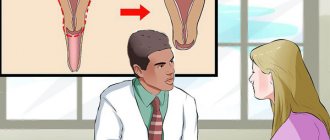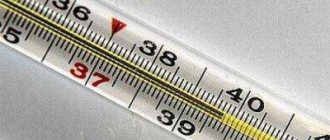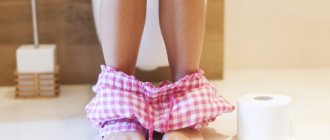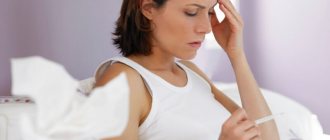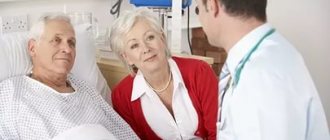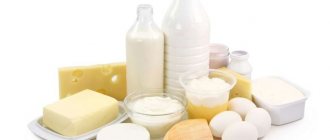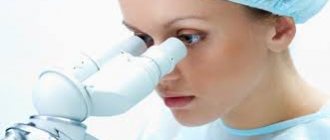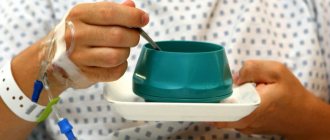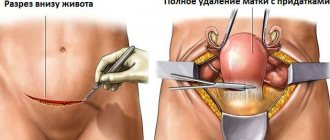If a woman has been diagnosed with uterine fibroids, then treatment can take place in two ways. In some cases, conservative treatment is chosen, when the tumor is treated with hormonal therapy; in other cases, surgery cannot be avoided. Regardless of how the operation was performed, the woman will need to undergo a rehabilitation period when removing a mass in the uterus. According to many women, the requirements after the operation are extremely strict, and the recommendations are simply impossible to follow, but is this really the case? How necessary it is to follow the recommendations given by doctors so that no negative consequences arise in the future.
https://youtu.be/scETyPzX6Qo
Types of fibroids
There are several criteria by which uterine fibroids are classified:
- location;
- specifics of growth;
- specific size of the tumor.
Pathology has many varieties, and they all depend on special criteria:
- Depending on the location, intermuscular submucosal, intermediate and abdominal fibroids are distinguished;
- depending on the size of the tumor, they are divided into large, medium and small tumors;
- pathology can occur anywhere in the organ, including the cervix and isthmus;
- also separate real and false pathologies;
- fibromyoma - this is the name the disease bears if most of the tumor consists of connective cells;
- in the case when the tumor forms in smooth muscle tissue, it is called uterine leomyoma;
- There is also such a type as simple fibroids - this is a formation in which the connective component dominates.
These types of tumors are classified depending on the characteristics of the location:
- subserous formation is located under the serous layer of the uterine wall, outside the organ. The tumor grows in the direction of the peritoneum, which is why the menstrual cycle is extremely rarely disrupted. If the tumor increases in volume, other symptoms may appear;
- submucosal formation is an extremely rare occurrence. Fibroids develop deep in the uterus, under the thin mucous layer of the inner lining of the uterine walls. It is quite simple to identify it using diagnostics; it has well-known symptoms that are pronounced;
- intramural formations appear in patients much more often than the previous types. It grows from the middle muscular layer of the uterine wall. Women feel heaviness, problems with menstrual functions and pain in the genitals appear.
Each type requires distinctive treatment. For this reason, each patient, after undergoing a detailed examination, receives a doctor’s prescription on a strictly individual basis. Ignoring the disease can cause serious consequences.
Causes of the disease
Unfortunately, at the moment, experts have not established the exact causes of uterine fibroids. However, some factors that can contribute to the development of tumor processes are known. The main cause is hormonal imbalance. As a rule, fibroids are found in women over 35 years of age. The cause of the development of pathology may be the use of oral contraceptives.
In addition, there are a number of reasons contributing to the disease:
- genetic inheritance - it was possible to prove that if the mother was diagnosed with uterine fibroids, the likelihood that her daughter will develop the disease at an earlier age is several times higher;
- early onset of the menstrual cycle or vice versa, later;
- a long period of absence of pregnancy, women who gave birth to a child before 25 years of age are less prone to the disease;
- insufficient physical activity, and as a result – obesity;
- regular stress, ecology - those women who hold high positions and live in megacities are more likely to develop pathology than others;
- mechanical damage to the uterine mucosa, including a large number of abortions, the presence of an intrauterine device;
- diabetes;
- ignoring other gynecological diseases, chronic infections;
- poor diet, consumption of unhealthy food and alcohol in large quantities;
- the tumor can also grow during pregnancy or during the use of hormonal contraceptives;
- with a low level of hormones in the blood, which is typical during menopause, the tumor may disappear on its own.
Diagnostics
At the first suspicion of a tumor, an urgent diagnosis is required, first of which an anamnesis is collected. During the consultation, women are usually asked a number of important questions that may affect their treatment. Particular attention is paid to the number of births and abortions, the presence of this pathology in relatives, intrauterine intervention and the duration of menstruation. Diagnosis of the disease is not difficult. If a routine gynecological examination shows that the uterus is enlarged, you should undergo an ultrasound of the pelvic organs. It will reveal details such as fibroid size, location and number of nodes.
Thanks to ultrasound scanning, it became possible to determine the location of the tumor and its size quite accurately. In order to best assess the characteristics of fibroids and visualize them, special sensors are used:
- transvaginal;
- transabdominal.
Three-dimensional echography and Dopplerography allow us to study in detail the flow of blood flow inside the formation. To clarify the structure of the myomatous node and carry out differential diagnosis, magnetic resonance or computed tomography is used. If there is a suspicion of a submucosal tumor, two methods will bring great diagnostic benefit: endoscopic and radiological. Diagnosis using laparoscopy is possible in case of subserous tumor location. It will also help assess the condition of the pelvic organs. With the help of histological examination of the removed nodes, you can find out the exact diagnosis; this procedure is mandatory for all patients. The further direction of treatment will depend on its results.
Symptoms
Sometimes a woman does not even suspect that she has a uterine tumor, because the symptoms do not always manifest themselves externally. Often, having gone to the gynecologist for completely different purposes, or after a routine medical examination, a woman finds out that she has fibroids. Only if the formation has reached a large size will the symptoms not be long in coming. The symptoms of uterine fibroids have common features with other diseases of the reproductive organs. Therefore, if you notice the signs described below, you should under no circumstances delay going to the doctor. An accurate diagnosis is urgently required.
List of symptoms:
- irregular menstrual cycle, spotting in the middle of the cycle;
- the development of uterine bleeding, and quite heavy bleeding - this is a rare case, but you still need to pay attention to it;
- frequent urination occurs due to the fact that a large tumor increases intra-abdominal pressure;
- irregular bowel movements;
- prolonged infertility, applies to both primary and secondary;
- a feeling of tightness in the lower abdomen, an unpleasant nagging pain, most often this is associated with impaired blood flow in the fibroid node;
- the belly increases in volume, this is not associated with gaining extra pounds.
General nutrition rules
The menu for uterine fibroids has one important goal, namely to prevent further progression and growth of the tumor. With proper nutrition, myomatous nodes can shrink. There are no strictly prescribed contraindications regarding nutrition for uterine fibroids, as such. It’s even difficult to call it a specific diet; it would be more accurate to say – the process of following all the principles of a proper diet, which will help strengthen women’s health and prepare it for further resistance to disease. Nutrition will also increase your level of stress resistance. With such a diagnosis, food intake should be balanced, followed by a basic list of rules that must be followed in the daily diet:
- In an untouchable order, include in the daily menu those products that will stop the development of the tumor;
- every day the body must receive the daily norm of important substances, such as nutrients, minerals and vitamins;
- it is advisable to exclude high-calorie foods, they are too heavy for the body, and with fibroids it will be weakened;
- foods in the diet should have antioxidant activity;
- when preparing dishes, you need to use those products that can restore the metabolic process and reduce cholesterol;
- it is necessary to exclude dishes that contain preservatives and other unhealthy ingredients;
- do not use oils and fats when cooking;
- eat at least 4 times a day, strictly observing the time;
- After lunch and in the evening, it is recommended to reduce the amount of fluid consumed, this will reduce the risk of uterine edema;
- drink at least 1.5 liters of water;
- consume large amounts of vegetables and fruits every day;
- refrain from eating late so as not to burden the stomach;
- It is important to know that following a diet can have a beneficial effect on the reduction of fibroids.
General rules
Removal of the uterus ( hysterectomy ) or the uterus and appendages ( hysterosalpingo-oophorectomy ) are the most common operations in gynecology. They are not necessarily used in the presence of malignant tumors. Indications may include trauma and heavy uterine bleeding, endometriosis , multiple or large leiomyomas , ovarian cysts, etc.
In any case, anesthesia and surgery are stress for the body, which causes local and general reactions and must be overcome. After abdominal intervention, the postoperative period is divided into early and late. The early one lasts the first three to four days, the second one lasts up to 12-20 days. On the first day, all patients are recommended to be completely hungry, and fluid losses are replenished with intravenous solutions. In the absence of vomiting, which is associated with irritation of the gastrointestinal mucosa by a narcotic substance, no earlier than 3-4 hours after the operation you can drink strong tea with lemon. And when an appetite appears (after 12-24 hours, depending on the condition), a woman can switch to light food: kefir, yogurt, broth.
Of course, a gentle diet is necessary, excluding aggressive, difficult-to-digest or irritating foods that irritate the gastrointestinal mucosa. This is explained by the fact that during abdominal surgery the peritoneum and intestinal loops are exposed, cooled and injured, no matter how carefully they are handled. General anesthesia also has a negative effect. This is why flatulence , pain and colic in the abdomen occur, which most often disappear by the third day.
Proper nutrition, which gradually expands, helps restore the function of the gastrointestinal tract. On the second day, add liquid porridge (oatmeal, semolina, buckwheat), vegetable puree, crackers, light cereal and vegetable soups, omelet, soft-boiled eggs. That is, it is recommended to eat within Table No. 1B .
It is mandatory to introduce into the diet foods that enhance intestinal motility: soaked prunes, grated beets with vegetable oil, or any foods familiar to a woman that stimulate bowel movements. After the first natural bowel movement, nutrition can be expanded, and meat, fish, and crumbly cereals are recommended. It is allowed to drink an infusion of rose hips and sea buckthorn, dried fruit compote, and jelly are limited if you are prone to constipation .
In general, nutrition after abdominal gynecological surgery is based on the principles:
- Fractionality - I take it up to 7 times a day in not very large portions.
- Inclusion of products to restore natural bowel function, since after strip surgery many experience bowel paresis. The emphasis is on foods containing dietary fiber (vegetables, prunes, fruits), but they should be boiled or stewed, as raw foods cause bloating.
- Avoiding foods that cause bloating. You should not eat bread, cabbage, carbonated water, legumes, yeast baked goods, kvass, raw vegetables and fruits, and whole milk.
- Exclusion of fixing products: strong tea and coffee, chocolate, rice, hard-boiled eggs.
- Gradual introduction of meat and fish dishes, especially if you are prone to constipation, since protein foods provoke them.
- Steaming or boiling dishes.
- Maintain a drinking regimen of 1.5 liters per day or more (as recommended by a doctor).
- Excluded from the diet: fatty and fried foods, confectionery, strong tea, coffee, spicy foods, spices, chocolate.
After discharge from the hospital, a relatively gentle diet should be followed for up to one month. For some women, this period is reduced to two weeks. It is imperative to monitor daily bowel movements to avoid constipation. After the operation, you are not allowed to push - this poses a threat to the sutures. In this regard, products that have a fixing effect and slow down peristalsis are initially excluded. These include pureed soups, boiled slimy porridges, jelly, rice and pureed food, chocolate, cottage cheese in large quantities, an abundance of meat products and protein foods in general, strong tea, cocoa, dough products, pomegranates, quince, blueberries, flour products a lot.
Bloating should also not be allowed, so legumes, kvass, black bread, grapes, raisins, herbs and spices should be excluded. At this stage, a balanced diet is important, since processes are activated: protein synthesis, necessary for growth and development, is enhanced. The functions of the gastrointestinal tract and cardiovascular system are restored.
Nutrition must include proteins, fats, vitamins and carbohydrates. On average, the calorie intake should be 2800-2900 kcal, protein up to 95 g, the same or slightly more fat and 400 g of complex carbohydrates. During the recovery period, it is important to eliminate the deficiency of proteins and vitamins that occurs due to blood loss, fever and breakdown of tissue proteins.
A sufficient amount of protein (meat, cottage cheese, dairy products, eggs, fish) and healthy fats, the sources of which are nuts, fatty fish, and vegetable oils (especially olive, sesame and flaxseed), are introduced into the diet. Restrictions apply only to simple carbohydrates (sweets, sugar, flour products). Complex carbohydrates (cereals, cereal breads, vegetables) are the main source of energy, so they must be included in the diet.
Allowed and healthy products
A diet for uterine fibroids will help women who have been diagnosed with this disease to recover. The following are foods that are beneficial for fibroids:
- The diet must include dishes that contain whole grains. They contain a lot of fiber. Therefore, to the question “Is it possible to eat pasta with fibroids?”, the answer is obvious - only from whole grains;
- it is also important that the body consumes nuts or legumes; nuts can be added to a salad, and soup can be made from peas;
- soy is very important for women with tumors, this product contains a significant percentage of anti-carcinogenic substances, it has beneficial properties that stop the growth of fibroids;
- a woman should eat at least 8 servings per day, which include fresh fruits and vegetables. It is desirable that 3 of them be different, the most useful for tumors are the following foods - carrots, lettuce, Brussels sprouts and white cabbage, oranges, tomatoes, pumpkin;
- the diet should include berries, including frozen and fresh; they are rich in vitamins, antioxidants and flavonoids;
- special attention should be paid to red grapes, they contain bioflavonoids - very powerful antioxidants. It also contains enzymes that have a positive effect on hormonal levels; red grapes will greatly help you in the process of getting rid of fibroids;
- Fish should be an important element of the diet for uterine fibroids and should be consumed at least 3 times a week. It is preferable to add tuna, sardines, salmon and mackerel to the menu;
- It is important that the diet contains a lot of herbs and various spices, but only if the patient does not have problems with the digestive tract. It is recommended to consume garlic;
- flaxseed contains many valuable vitamins, as well as Omega-3. Any dish would be incomplete without a spoonful of flaxseed;
- As for drinks, green tea is the most beneficial. More than 4 cups a day - this is exactly the amount of tea you can drink while on a diet. It doesn't matter whether it's cold or hot. Thanks to epigallo-catechin galan in its composition, it has anti-carcinogenic properties;
- Dairy products are very useful for fibroids. With this diagnosis, you need to drink a glass of milk every few days. However, its fat content should be low.
Authorized Products
The diet after abdominal gynecological surgery includes:
- Dishes made from lean beef, chicken, veal, rabbit, steamed or boiled. Depending on your preference, you can cook the meat in the form of chopped products (cutlets, meatballs, etc.) or in pieces.
- Soups with vegetable or weak meat broths. They add cereals, vermicelli and vegetables.
- Dried wheat bread is limited at first. Dry cookies are introduced.
- Low-fat fish at first, and during the rehabilitation period the diet is expanded by introducing fatty fish 1-2 times a week. Cooking method: steamed, boiled or baked.
- Soft-boiled eggs or omelet.
- Low-fat milk is initially limited or excluded due to possible bloating of the intestines after consumption. Then it is introduced into dishes (milk porridge, milk soups). Sour cream as a seasoning for dishes. Any fermented milk drinks that are well tolerated. Half-fat cottage cheese is limited only if you are prone to constipation.
- Cereals in the form of porridges and casseroles. It is worth considering that corn, pearl barley, millet and barley are difficult to digest, so they are excluded for two weeks after the operation and then carefully introduced.
- At first, vegetables are consumed boiled, baked or stewed, excluding coarse ones (radish, radish, mushrooms). They are used to make puree, caviar, and stew. Subsequently, vegetables are introduced fresh - salads with vegetable oil.
- Fruits and berries are first consumed in heat-treated form - compotes, as an additive when cooking porridge, jelly (in the absence of constipation).
- Drinks: vegetable and fruit juices, rosehip infusion, still water, weak tea (with milk), oat decoction is useful.
Table of permitted products
| Proteins, g | Fats, g | Carbohydrates, g | Calories, kcal | |
Vegetables and greens | ||||
| eggplant | 1,2 | 0,1 | 4,5 | 24 |
| zucchini | 0,6 | 0,3 | 4,6 | 24 |
| cabbage | 1,8 | 0,1 | 4,7 | 27 |
| broccoli | 3,0 | 0,4 | 5,2 | 28 |
| carrot | 1,3 | 0,1 | 6,9 | 32 |
| cucumbers | 0,8 | 0,1 | 2,8 | 15 |
| salad pepper | 1,3 | 0,0 | 5,3 | 27 |
| parsley | 3,7 | 0,4 | 7,6 | 47 |
| iceberg lettuce | 0,9 | 0,1 | 1,8 | 14 |
| tomatoes | 0,6 | 0,2 | 4,2 | 20 |
| pumpkin | 1,3 | 0,3 | 7,7 | 28 |
| dill | 2,5 | 0,5 | 6,3 | 38 |
Fruits | ||||
| bananas | 1,5 | 0,2 | 21,8 | 95 |
| apples | 0,4 | 0,4 | 9,8 | 47 |
Nuts and dried fruits | ||||
| nuts | 15,0 | 40,0 | 20,0 | 500 |
| dried figs | 3,1 | 0,8 | 57,9 | 257 |
| dried apricots | 5,2 | 0,3 | 51,0 | 215 |
| dried apricots | 5,0 | 0,4 | 50,6 | 213 |
| prunes | 2,3 | 0,7 | 57,5 | 231 |
Cereals and porridges | ||||
| buckwheat (kernel) | 12,6 | 3,3 | 62,1 | 313 |
| oat groats | 12,3 | 6,1 | 59,5 | 342 |
| pearl barley | 9,3 | 1,1 | 73,7 | 320 |
Flour and pasta | ||||
| buckwheat noodles | 14,7 | 0,9 | 70,5 | 348 |
Bakery products | ||||
| bran bread | 7,5 | 1,3 | 45,2 | 227 |
| whole grain bread | 10,1 | 2,3 | 57,1 | 295 |
Confectionery | ||||
| jam | 0,3 | 0,2 | 63,0 | 263 |
| fruit and berry marmalade | 0,4 | 0,0 | 76,6 | 293 |
| paste | 0,5 | 0,0 | 80,8 | 310 |
| Maria cookies | 8,7 | 8,8 | 70,9 | 400 |
Raw materials and seasonings | ||||
| honey | 0,8 | 0,0 | 81,5 | 329 |
Dairy | ||||
| kefir 1.5% | 3,3 | 1,5 | 3,6 | 41 |
| Ryazhenka | 2,8 | 4,0 | 4,2 | 67 |
Cheeses and cottage cheese | ||||
| cottage cheese 1% | 16,3 | 1,0 | 1,3 | 79 |
Meat products | ||||
| beef | 18,9 | 19,4 | 0,0 | 187 |
| rabbit | 21,0 | 8,0 | 0,0 | 156 |
Bird | ||||
| boiled chicken breast | 29,8 | 1,8 | 0,5 | 137 |
| boiled chicken drumstick | 27,0 | 5,6 | 0,0 | 158 |
| boiled turkey fillet | 25,0 | 1,0 | — | 130 |
Eggs | ||||
| soft-boiled chicken eggs | 12,8 | 11,6 | 0,8 | 159 |
Fish and seafood | ||||
| flounder | 16,5 | 1,8 | 0,0 | 83 |
| pollock | 15,9 | 0,9 | 0,0 | 72 |
| cod | 17,7 | 0,7 | — | 78 |
| hake | 16,6 | 2,2 | 0,0 | 86 |
Oils and fats | ||||
| butter | 0,5 | 82,5 | 0,8 | 748 |
| olive oil | 0,0 | 99,8 | 0,0 | 898 |
| sunflower oil | 0,0 | 99,9 | 0,0 | 899 |
Non-alcoholic drinks | ||||
| water | 0,0 | 0,0 | 0,0 | — |
| mineral water | 0,0 | 0,0 | 0,0 | — |
| green tea | 0,0 | 0,0 | 0,0 | — |
Juices and compotes | ||||
| apricot juice | 0,9 | 0,1 | 9,0 | 38 |
| carrot juice | 1,1 | 0,1 | 6,4 | 28 |
| peach juice | 0,9 | 0,1 | 9,5 | 40 |
| plum juice | 0,8 | 0,0 | 9,6 | 39 |
| tomato juice | 1,1 | 0,2 | 3,8 | 21 |
| pumpkin juice | 0,0 | 0,0 | 9,0 | 38 |
| rose hip juice | 0,1 | 0,0 | 17,6 | 70 |
| * data is per 100 g of product | ||||
What foods should you not eat?
It is important to remember that many products have a rather harmful composition, with many chemical elements, this means preservatives and carcinogens. They can negatively affect the tumor and accelerate the development of fibroids.
What foods should be excluded from the diet if you have uterine fibroids:
- all fast food products;
- sausages of all kinds. We'll have to give up smoked sausage and other things;
- you should avoid fatty meats and lard;
- products subject to preservation are something that should not be eaten under any circumstances, just like smoked ones;
- confectionery products, including sweets, cakes and more;
- butter and margarine;
- the amount of vegetable oil should be limited.
Fully or partially limited products
Meals after hysterectomy should not contain:
- Semi-finished products, fast food, shelf-stable products and those with chemical additives, fatty red meat.
- Sausages, smoked meats, refractory, animal/cooking fats, margarine, mayonnaise, canned fish/meat.
- For the first time after surgery, it is worth limiting the consumption of legumes and vegetables that cause bloating: garlic, peas, lentils, beans, soybeans, onions, peppers, cabbage.
- The consumption of offal is limited to once every 2 weeks.
- It is not advisable to consume rich meat/fish broths, spicy and pickled vegetables.
- Carbonated drinks, strong tea, strong coffee, packaged juices.
- The consumption of confectionery products, sugar, products made from refined flour, whole milk, yeast, and baked goods is limited.
Table of prohibited products
| Proteins, g | Fats, g | Carbohydrates, g | Calories, kcal | |
Vegetables and greens | ||||
| canned vegetables | 1,5 | 0,2 | 5,5 | 30 |
| horseradish | 3,2 | 0,4 | 10,5 | 56 |
Mushrooms | ||||
| mushrooms | 3,5 | 2,0 | 2,5 | 30 |
Confectionery | ||||
| pastry cream | 0,2 | 26,0 | 16,5 | 300 |
| cake | 3,8 | 22,6 | 47,0 | 397 |
| shortbread dough | 6,5 | 21,6 | 49,9 | 403 |
Cakes | ||||
| cake | 4,4 | 23,4 | 45,2 | 407 |
Chocolate | ||||
| chocolate | 5,4 | 35,3 | 56,5 | 544 |
Raw materials and seasonings | ||||
| mustard | 5,7 | 6,4 | 22,0 | 162 |
| ketchup | 1,8 | 1,0 | 22,2 | 93 |
| mayonnaise | 2,4 | 67,0 | 3,9 | 627 |
Dairy | ||||
| cream 35% (fat) | 2,5 | 35,0 | 3,0 | 337 |
Meat products | ||||
| fatty pork | 11,4 | 49,3 | 0,0 | 489 |
| salo | 2,4 | 89,0 | 0,0 | 797 |
| bacon | 23,0 | 45,0 | 0,0 | 500 |
| raw smoked pork belly | 7,6 | 66,8 | — | 632 |
Sausages | ||||
| smoked sausage | 16,2 | 44,6 | 0,0 | 466 |
| dry-cured sausage | 24,1 | 38,3 | 1,0 | 455 |
| smoked sausage | 9,9 | 63,2 | 0,3 | 608 |
Bird | ||||
| fried chicken | 26,0 | 12,0 | 0,0 | 210 |
| smoked chicken | 27,5 | 8,2 | 0,0 | 184 |
| duck | 16,5 | 61,2 | 0,0 | 346 |
| smoked duck | 19,0 | 28,4 | 0,0 | 337 |
| goose | 16,1 | 33,3 | 0,0 | 364 |
Fish and seafood | ||||
| dried fish | 17,5 | 4,6 | 0,0 | 139 |
| smoked fish | 26,8 | 9,9 | 0,0 | 196 |
| canned fish | 17,5 | 2,0 | 0,0 | 88 |
Oils and fats | ||||
| creamy margarine | 0,5 | 82,0 | 0,0 | 745 |
| cooking fat | 0,0 | 99,7 | 0,0 | 897 |
| rendered pork fat | 0,0 | 99,6 | 0,0 | 896 |
Non-alcoholic drinks | ||||
| Pepsi | 0,0 | 0,0 | 8,7 | 38 |
| sprite | 0,1 | 0,0 | 7,0 | 29 |
| tonic | 0,0 | 0,0 | 8,3 | 34 |
| Fanta | 0,0 | 0,0 | 11,7 | 48 |
* data is per 100 g of product
The role of diet after surgery and its principles
After abdominal surgery to remove fibroids, diet plays an important role. In the postoperative period, the woman must follow a special diet. The entire diet is based on the fact that most patients develop dehydration, protein deficiency and vitamin deficiency. Nutrition should help adjust metabolism and, most importantly, provide all the needs of the body, which after surgery especially needs to strengthen its defenses. In order for rehabilitation to take place as quickly as possible, all foods that can cause flatulence must be excluded from the diet. The first postoperative days deserve special attention; they are the most important. During this period, the diet should be as gentle as possible. With such a meal, the body will receive nutrients that can be easily absorbed.
After a while, the diet becomes less careful. Regular food will replace liquid food. This will reduce the stress placed on the body due to the operation and allow it to return to normal functioning more quickly. It is important to remember that most patients after the operation cannot move for some time without assistance. Due to the fact that all the body’s energy needs to be used for healing and restoration processes, nutrition should consist of easily digestible foods. All the body's forces should help recovery, and not be wasted on digesting heavy food.
After removal of uterine fibroids, you need to adhere to the basic rules of dietary nutrition:
- eat often, but not much; the larger the volume of food, the longer the digestive tract will absorb it;
- the volume of one serving should not exceed 200 g;
- you need to eat food enriched with vitamins and microelements;
- The volume of fluid is individual for each patient, so you need to listen to the doctor’s instructions. It is forbidden to increase the volume of fluid consumed on your own; this can lead to tissue swelling.
General principles:
- after completion of the operation, for 12 hours, you can drink only clean water, no food. As soon as the required time has passed, you can eat semi-liquid foods, light broths and low-fat yoghurts;
- It is advisable to add all new products gradually, no more than 2 per day. Then the body, which is just recovering from the stress received, will get used to them faster. This will also allow you to monitor his reaction to the products.
Diet for quick recovery after surgery
The operation affects not only the genital organs directly, but also the wall of the peritoneum, which means that it is necessary to organize the work of the organs located here so as not to provoke tissue injury.
That is why, after abdominal surgery, doctors prescribe a diet to the woman. On days 1 and 2 after the intervention, the patient is given only liquid food - broth, yogurt, weak tea. Constipation is unacceptable because it provokes tension in the abdominal muscles during bowel movements.
From day 3, you can eat fruits and vegetables rich in fiber to cleanse your intestines. If fresh fruits cause fermentation in the intestines, then you can bake and boil them.
Dietary meals include:
- lean meat and fish; buckwheat and oatmeal; soups with vegetable broths, rarely with weak meat broths; Rye bread; dairy products; fruits, herbs and vegetables.
During recovery, you should exclude jelly and jelly, semolina and rice, strong tea and coffee, soda, fatty meat, sweets and baked goods from your diet.
Menu for the week
Monday:
- For breakfast, buckwheat porridge with water is perfect, which should be washed down with rosehip tea or honey;
- blueberry yogurt is a great option for your next meal;
- for lunch it is better to eat light bean soup and a small piece of fish (steamed), a salad of vegetables or fruits (your choice);
- The basis of the afternoon snack will be dried fruits, washed down with green tea;
- For a light dinner, make a stew and add nuts.
Tuesday:
- oatmeal with water is suitable for breakfast, drink – green tea;
- after a while you can eat a bunch of grapes;
- salad, chicken breast (steamed or boiled), lentil soup - an excellent option for lunch;
- for an afternoon snack, cottage cheese and a little honey;
- for dinner, rice casserole with carrot salad.
Wednesday:
- for breakfast, lazy dumplings and rosehip broth;
- a couple of pieces of pineapple are an excellent option for second breakfast;
- for lunch, salad, carrot cutlet, tea, mushroom soup;
- an apple for a light afternoon snack;
- for dinner, beet salad and stewed potatoes.
Thursday:
- rice porridge and a cup of coffee for breakfast;
- snack on a banana;
- For lunch, eat boiled fish and beetroot, wash down with compote.
- fruit jelly is suitable for an afternoon snack;
- We have dinner with pilaf and dried fruits.
Friday:
- for breakfast omelette with green peas, tea;
- a glass of any berries is perfect for second breakfast;
- for lunch fish soup, tea, dumplings with potatoes;
- as an afternoon snack - compote with a couple of crackers;
- for dinner, stewed eggplants.
Saturday:
- breakfast consists of semolina porridge with nuts, drink – a glass of tea;
- cottage cheese for second breakfast;
- for lunch, cabbage soup, meatballs, washed down with compote;
- for an afternoon snack - cottage cheese;
- for dinner, tea and a portion of vegetable cabbage rolls.
Sunday:
- fresh juice and oatmeal for breakfast;
- We eat a pear as a second breakfast;
- for lunch, rice soup, tea, potato casserole;
- for an afternoon snack - nuts;
- For dinner, buckwheat, vegetables and tea.
Treatment
There are many treatments available, but to date only three have been found effective.
Surgical intervention
Removing uterine fibroids through surgery is called a myomectomy. It can be done using two methods: laparoscopic and classical (by incision). The latter method has somewhat lost its popularity; now doctors prefer laparoscopic intervention. A resectoscope is a special endoscopic instrument that removes nodes located in the uterine cavity through the vagina. The advantage of this procedure is that it is a surgical method, but at the same time, this is precisely the disadvantage. This is interconnected with the possible complications that such an intervention and anesthesia entail. There is a high probability of relapse, and it can only be avoided with the help of hormonal drugs. It is important to remember that tumor removal for those women who want to get pregnant is not the most optimal solution. A complication in the form of adhesions in the pelvis is possible, which can lead to tubo-peritoneal infertility. This occurs due to the fact that during the operation the patency of the fallopian tubes is disrupted and, after fertilization, the egg does not enter the uterus.
Uterine artery embolization
During this procedure, an embolic drug is injected through a catheter into the vessels that supply the fibroid. It consists of particles that take oxygen away from pathological tissues and block the flow of blood flow in the vessels of the fibroids. As a result, the myomatous node dies. Treatment of EMA fibroids is not an innovation at all; it was developed back in the last century, around the seventies.
Benefits of EMA
- high level of effectiveness, the possibility of relapse is at a minimum, most patients no longer resort to any treatment methods;
- in more than 90% of women, the menstrual cycle returns to normal, in almost 100% problems with urination disappear;
- safety - there is no risk that exists with myomectomy, this procedure is carried out without anesthesia, and it takes a little more than 10 minutes. In just a couple of days, the patient can be discharged from the hospital, and the rehabilitation period will take a week.
Drug treatment
Today, for the treatment of tumors, it is reasonable to use ulipristal acetate, which blocks progesterone receptors. It should be taken in 2-3 cycles and take breaks of 2 months, while monitoring the dynamics of changes using ultrasound. The drug has both positive and negative sides. A clear advantage is ease of portability. But the disadvantage can be called the unknown, because... there is no exact information about how long the result will last and after what period of time a relapse will occur, or whether it will happen at all.
Stages of the rehabilitation period
Hysterectomy, as a last resort measure for the treatment of gynecological diseases, is used when detecting:
- malignant formation;
- risk of cyst degeneration;
- benign tumor;
- injuries with extensive uterine bleeding.
The development of technology allows surgeons to successfully perform operations; they place the main emphasis on reconstructive procedures.
The diet after surgery to remove the uterus is justified by the following reasons:
- Surgery negatively affects the gastrointestinal tract, and proper nutrition regulates the functions of the system.
- The operation contributes to a sharp hormonal imbalance after the removal of a single genital organ, and weight gain occurs. Only diet will help normalize it; hormonal therapy alone cannot cope.
- General anesthesia puts a stressful situation on the body. Correcting the problem requires time and nutritious food that can restore vital functions.
- Saturating the body with useful substances will help a woman endure general weakness, nausea after chemotherapy, complex procedures prescribed for the treatment of a serious illness.
Attending physicians divide postoperative observation of patients into stages:
- early;
- late;
- outpatient.
The first 3 days after surgery are the most critical. During this period, the body is cleansed, it fights for its restoration.
The gynecologist makes sure that no complications arise:
- thrombosis;
- bleeding;
- intestinal disorders with bloating.
On day 4 and until discharge from the hospital:
- the wound is healing;
- the intestines normalize their functioning;
- metabolic processes are restored.
When a patient goes home for outpatient treatment, her health will depend on factors: how the woman or relatives organize their diet and follow a regimen appropriate to the case.
Traditional medicine
Treating uterine fibroids with folk remedies is much better than resorting to surgery, however, folk remedies should only be used under the supervision of a doctor. This will eliminate the possibility of complications developing. If you choose home therapy methods well, this will allow you to:
- relieve pain symptoms;
- stop the inflammatory process;
- to induce a reduction and stop the development of myomatous nodes, the likelihood of complete resorption of the tumor is considered.
But it is important to remember that folk remedies can bring maximum effect only in the first stages of uterine fibroids, in which case over time you can observe how it decreases. If the tumor is small and does not grow rapidly, it is quite possible to treat it with folk remedies, including herbal remedies, etc. The goal of treatment is to eliminate symptoms and stop the development of the tumor, which is why agents that have an antitumor effect, as well as hemostatic, will have a special effect. If the fibroid has managed to grow to a large size, then folk remedies will provide minimal assistance. This is due to the fact that the fibroids are already in a fairly advanced state. However, with the help of traditional medicine it is possible to stop the growth of the tumor and reduce its size.
Herbs for treatment. In the treatment of uterine fibroids, herbal medicine will be especially effective. There is a special group of plants, numbering many species, that help eliminate the tumor process. Such plants will be able to cope with any neoplasm, but doctors treat them with skepticism, due to the fact that a significant part of the herbs are poisonous. Among them: hemlock, marsh cinquefoil, etc. There is another group of herbs - queen cells, which will help the fibroids begin to shrink. These plants have the ability to have a healing effect on tumor processes occurring in the uterus. Among them: celandine, European grasshopper, crazy cucumber, etc. In traditional treatment, it is contraindicated to resort to procedures that involve hot baths and compresses. You can only use products that have been verified.
Prevention
The most significant problem at this moment is the prevention of uterine fibroids. The main prerequisites for all types of diseases are regular stressful situations and unhealthy lifestyle, and uterine fibroids are no exception. The cause of the tumor can be an acute emotional outburst, as well as routine experiences that affect the endocrine and immune systems. A short list of tips for preventing the disease:
- balanced diet;
- physical exercise;
- a trip to the gynecologist, once every six months;
- regular sex life.
Pregnancy and breastfeeding can relieve many gynecological problems, including uterine fibroids. These factors have a positive effect on the level of a woman’s psychological state. You should avoid hypothermia and getting wet, especially take care of your feet, knees and buttocks. Clothing and shoes should be selected according to the season. It is advisable to wear synthetic underwear as little as possible, this also applies to tight trousers - this type of clothing delays heat transfer. You need to take vitamins E, A, C, as well as microelements such as iodine, copper and iron. A mandatory requirement for prevention is weight control; extra pounds can contribute to the development of the disease. Prevention of uterine fibroids consists of two points:
- maintaining a correct lifestyle;
- care for reproductive function.
Possible consequences
The most dangerous consequence can be the development of malignant processes. The risk that the tumor will degenerate into cancer is extremely small, however, it still exists. If a woman is diagnosed with such a pathology, she should undergo regular examinations with a doctor and monitor changes in the size of the fibroids. If it grows rapidly, this is the main sign that the tumor may become malignant. Other consequences are not so dangerous and do not pose a threat to life. We are talking about infertility and the development of anemia. Over the past few years, the number of women who have had their uterus removed due to fibroids has increased. This procedure is extremely stressful for any woman. Necrosis of the node and the appearance of a submucous node requires urgent laparotomy. If it is simply impossible to avoid such an operation, the woman should think about the situation, calm down and come to the right decision. The uterus is an obligatory organ only when a woman is going to carry a baby. If you already have children, then it is better to agree to the operation. After all, a malignant tumor can form from fibroids. The right decision is obvious.
Reviews and results
There is no specially designed diet for cancer. In general, food does not have significant restrictions and corresponds to a healthy diet. In each specific case, taking into account the patient’s conditions, adjustments are made. A properly organized healthy diet can speed up rehabilitation after chemotherapy and radiation therapy and normalize the condition.
- “...I had surgery, plus chemotherapy and radiation. It was difficult to bear everything. The prognosis was not encouraging, but you have to get through it! I followed the diet strictly, began to eat more vegetables, cereals, vegetable oils and fish. There were no problems with the intestines, I didn’t feel weak or bloated, and this allowed me to eat a lot of seasonal vegetables. I eat chicken twice a week. I tolerate all products well. I see a doctor every six months and have been leading the life of a healthy person for three years now”;
- “... They removed the uterus and ovaries, underwent chemotherapy, but did not undergo radiation. However, the recovery was long. As a result of treatment, I lost a lot of weight and became weak - there was vomiting, nausea, and then there was no appetite for a long time. The doctor recommended a nutritious diet, which I could only do between chemotherapy courses. Only after 2 months did I manage to regulate my diet - I began to enjoy eating fish, stewed vegetables, honey, nuts, yogurt (I made it myself) and porridge”;
- “... Three years have passed since the removal of the uterus. The first two months were difficult: poor appetite, weakness, periodic nausea. I lost 6 kg. At first I strictly followed a diet, mainly rice, buckwheat, fish, cottage cheese, kefir, white chicken meat, omelettes, vegetables, fruits, honey and nuts. I drink a lot of water. After a year, I occasionally began to allow myself cakes and cakes, but otherwise my diet is correct. The weight has been restored, my hair has grown, I feel normal.”

